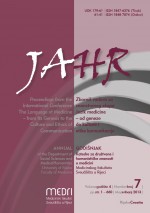Communication of persons with mental disorders
Sažetak
Mental disorders cover a wide spectrum of various diseases, including organic, symptomatic, neurotic, affective diseases, schizophrenic and craziness diseases, mental backwardness and other mental disorders as well as mental disorders and behavioural diseases caused by the use of psychoactive substances, including alcohol, tobacco, drugs and other, traditionally called diseases of addiction.The problems in communication with the persons with mental disorders are often connected with the nature of their disabilities. The psychotic patients have quite developed and saved senses, but they have difficulties in the processing and interpretation of what they hear, see and touch. The speech of the persons with mental disabilities is poor and with a limited vocabulary. it reflects with a disability in the mental processes, emotions and motivation. The face expression of the persons with acute mental disabilities does not match the verbal message, and is usually expressed as illogical thinking processes in the form of illusions an hallucinations. to be able to enable persons with mental disabilities to communicate, we should do the fol-lowing:• in the communication with the users we have to be patient, with a high level of tolerance and respect towards the personality of the user;• a shorter transfer of communication is better, a shorter exchange, use of simple, short sentences, giving different shapes of social support e.g. organizing different games, walks in nature, collation of the psychical appearance with the purpose to encourage a certain type of interaction;• it is not good to interfere with the hallucinogenic contents of the user and• it’s necessary to understand, accept and support their feelings with the purpose to de-velop a mutual trust. with the users who have a certain type of communication limitations regarding their abilities it is necessary:• to talk loud and clearly with a certain normal speed with the purpose, the user to under-stand the content of the message easily;• if we notice that the user has not understood the message we are sending towards him, it is necessary to repeat the message, but use different words;• it is desirable to accept a certain member of the user’s family that would aid as a mediator in the communication of the user and as a source for gaining information;• to check if the user has understood what we’ve told him by the repetition or via short summarizing of the conversational content;• Using other forms of communication (sign language, written messages or pictures);• not to make fast conclusions of what the user is saying, but change of the type of com-munication (use of additional questions of a closed type - yes or no) and• to motivate the user’s memory, to remind him/her of a certain therapy or a certain event that occurred recently.
##submission.downloads##
Objavljeno
Broj časopisa
Rubrika
Autorska prava
Autori koji objavljuju u ovom časopisu slažu se sa slijedećim uvjetima:
- Autori zadržavaju autorska prava i dodjeljuju pravo časopisu na prvo objavljivanje uz istovremeno uvažavanje Creative Commons Attribution License koje omogućava drugima da dijele rad uz priznavanje njegova autorstva i početne objave u ovom časopisu.
- Autori mogu sklopiti zasebne, dodatne ugovorne dogovore o neekskluzivnoj distribuciji objavljene verzije rada (npr. objaviti ga u repozitoriju institucije ili ga objaviti u knjizi), uz priznavanje da je njegova početna objava bila u ovom časopisu.
- Autorima je dopušteno i ohrabruje ih se da objavljuju svoje radove putem društvenih mreža (npr. u repozitoriju institucije ili na njenim internetskim stranicama) prije i za vrijeme prijave obzirom da to može doprinijeti produktivnoj razmijeni te ranijeg i većeg citiranja objavljenog rada (Vidjeti: The Effect of Open Access).



